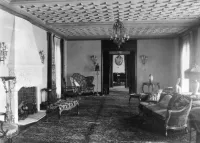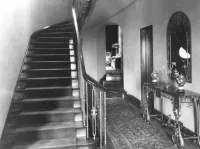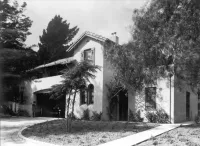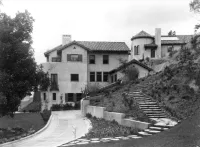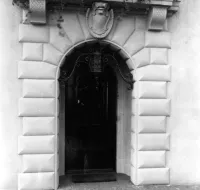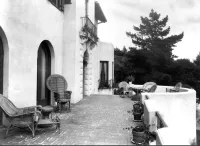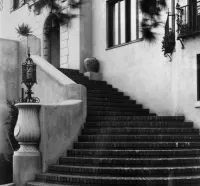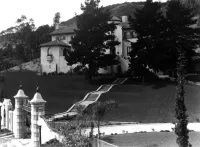Share what you know,
and discover more.
Share what you know,
and discover more.
May 31, 2008
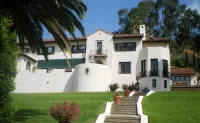
-

- Charmaine Bantugan
C.E. Toberman Estate
The C. E. Toberman Estate, also known as Villa Las Colinas, is a gated Mission Revival mansion and estate on Camino Palmero in Hollywood, Los Angeles, California. It was listed on the National Register of Historic Places in 1983, and as a Los Angeles Historic-Cultural Monument in 1984. Architecture In 1922, C. E. Toberman hired architects Russell & Alpaugh to design his Mission Revival and Spanish Colonial Revival style dream house, which took two years to build and was completed in 1924.[3] The estate, built on a 2-acre (8,100 m2) lot, includes a 19-room, 9,800-square-foot (910 m2) main house, a 1,809-square-foot (168.1 m2) guest apartment and garage, and a separate natatorium with a 30 by 50-foot (15 m) tiled pool with cabanas under skylights. The main house has eight fireplaces, a butler's pantry and cut-crystal doorknobs. Toberman, who lived to be 101 years old, recalled in a 1981 interview that the estate became "practically a country club" with its enclosed swimming pool, tennis courts, a nine-hole pitch-and-putt golf course, and formal gardens. History The house was built for Charles E. Toberman (1880-1981), a noted real estate developer who was known as "Mr. Hollywood" and the "Father of Hollywood" for his role in developing Hollywood and many of its landmarks, including the Hollywood Bowl, Grauman's Chinese Theatre, the Roosevelt Hotel, the Grauman's Egyptian Theatre and the Hollywood Masonic Temple. The house was reportedly featured in the first issue of Architectural Digest with a young Bette Davis at the front door. The Toberman family lived at the estate until 1941. It was situated on one of the most exclusive streets in Hollywood, adjacent to the Errol Flynn estate and with neighbors including Bette Davis, Samuel Goldwyn, Preston Sturges, Al Jolson, Ozzie and Harriet Nelson and Fatty Arbuckle. In 1980, the Toberman estate sold for $1 million (then a record price for a house in the Los Colinos section of Hollywood), and it was listed for sale in 1982 at a price of $1.5 million. The estate was placed on the National Register of Historic Places in 1983, after the property was purchased and renovated by Beverly Hills attorney and investor Donald L. Hunt. In the 1980s the house was recommended for Historic-Cultural Monument status by the Los Angeles Cultural Heritage Commission, but the proposal was initially rejected by the City Council because "the property owner and the councilman of the district object." The estate was later designated as Historic Cultural Monument #285. Filming location The Toberman Estate has long been a popular filming location. In 1990, it was the principal filming location for the film Where Sleeping Dogs Lie. The Toberman Estate was also used as the home of Vincent Chase on the first two seasons of HBO's Entourage and the later sixth season. The estate was later renamed "Villa Las Colinas" and is rented for receptions and special events. August 2009 Fire On the morning of August 30, 2009, a fire broke out in the kitchen of the main house. The Los Angeles Fire Department responded at 8:29 AM with 130 firefighters. The flames spread to the attic, and it took just over two hours for it to be extinguished. Two firefighters received minor injuries and were taken to local hospitals.
C.E. Toberman Estate
The C. E. Toberman Estate, also known as Villa Las Colinas, is a gated Mission Revival mansion and estate on Camino Palmero in Hollywood, Los Angeles, California. It was listed on the National Register of Historic Places in 1983, and as a Los Angeles Historic-Cultural Monument in 1984. Architecture In 1922, C. E. Toberman hired architects Russell & Alpaugh to design his Mission Revival and Spanish Colonial Revival style dream house, which took two years to build and was completed in 1924.[3] The estate, built on a 2-acre (8,100 m2) lot, includes a 19-room, 9,800-square-foot (910 m2) main house, a 1,809-square-foot (168.1 m2) guest apartment and garage, and a separate natatorium with a 30 by 50-foot (15 m) tiled pool with cabanas under skylights. The main house has eight fireplaces, a butler's pantry and cut-crystal doorknobs. Toberman, who lived to be 101 years old, recalled in a 1981 interview that the estate became "practically a country club" with its enclosed swimming pool, tennis courts, a nine-hole pitch-and-putt golf course, and formal gardens. History The house was built for Charles E. Toberman (1880-1981), a noted real estate developer who was known as "Mr. Hollywood" and the "Father of Hollywood" for his role in developing Hollywood and many of its landmarks, including the Hollywood Bowl, Grauman's Chinese Theatre, the Roosevelt Hotel, the Grauman's Egyptian Theatre and the Hollywood Masonic Temple. The house was reportedly featured in the first issue of Architectural Digest with a young Bette Davis at the front door. The Toberman family lived at the estate until 1941. It was situated on one of the most exclusive streets in Hollywood, adjacent to the Errol Flynn estate and with neighbors including Bette Davis, Samuel Goldwyn, Preston Sturges, Al Jolson, Ozzie and Harriet Nelson and Fatty Arbuckle. In 1980, the Toberman estate sold for $1 million (then a record price for a house in the Los Colinos section of Hollywood), and it was listed for sale in 1982 at a price of $1.5 million. The estate was placed on the National Register of Historic Places in 1983, after the property was purchased and renovated by Beverly Hills attorney and investor Donald L. Hunt. In the 1980s the house was recommended for Historic-Cultural Monument status by the Los Angeles Cultural Heritage Commission, but the proposal was initially rejected by the City Council because "the property owner and the councilman of the district object." The estate was later designated as Historic Cultural Monument #285. Filming location The Toberman Estate has long been a popular filming location. In 1990, it was the principal filming location for the film Where Sleeping Dogs Lie. The Toberman Estate was also used as the home of Vincent Chase on the first two seasons of HBO's Entourage and the later sixth season. The estate was later renamed "Villa Las Colinas" and is rented for receptions and special events. August 2009 Fire On the morning of August 30, 2009, a fire broke out in the kitchen of the main house. The Los Angeles Fire Department responded at 8:29 AM with 130 firefighters. The flames spread to the attic, and it took just over two hours for it to be extinguished. Two firefighters received minor injuries and were taken to local hospitals.
May 31, 2008
C.E. Toberman Estate
The C. E. Toberman Estate, also known as Villa Las Colinas, is a gated Mission Revival mansion and estate on Camino Palmero in Hollywood, Los Angeles, California. It was listed on the National Register of Historic Places in 1983, and as a Los Angeles Historic-Cultural Monument in 1984.Architecture
In 1922, C. E. Toberman hired architects Russell & Alpaugh to design his Mission Revival and Spanish Colonial Revival style dream house, which took two years to build and was completed in 1924.[3] The estate, built on a 2-acre (8,100 m2) lot, includes a 19-room, 9,800-square-foot (910 m2) main house, a 1,809-square-foot (168.1 m2) guest apartment and garage, and a separate natatorium with a 30 by 50-foot (15 m) tiled pool with cabanas under skylights. The main house has eight fireplaces, a butler's pantry and cut-crystal doorknobs. Toberman, who lived to be 101 years old, recalled in a 1981 interview that the estate became "practically a country club" with its enclosed swimming pool, tennis courts, a nine-hole pitch-and-putt golf course, and formal gardens.
History
The house was built for Charles E. Toberman (1880-1981), a noted real estate developer who was known as "Mr. Hollywood" and the "Father of Hollywood" for his role in developing Hollywood and many of its landmarks, including the Hollywood Bowl, Grauman's Chinese Theatre, the Roosevelt Hotel, the Grauman's Egyptian Theatre and the Hollywood Masonic Temple.
The house was reportedly featured in the first issue of Architectural Digest with a young Bette Davis at the front door. The Toberman family lived at the estate until 1941. It was situated on one of the most exclusive streets in Hollywood, adjacent to the Errol Flynn estate and with neighbors including Bette Davis, Samuel Goldwyn, Preston Sturges, Al Jolson, Ozzie and Harriet Nelson and Fatty Arbuckle.
In 1980, the Toberman estate sold for $1 million (then a record price for a house in the Los Colinos section of Hollywood), and it was listed for sale in 1982 at a price of $1.5 million. The estate was placed on the National Register of Historic Places in 1983, after the property was purchased and renovated by Beverly Hills attorney and investor Donald L. Hunt. In the 1980s the house was recommended for Historic-Cultural Monument status by the Los Angeles Cultural Heritage Commission, but the proposal was initially rejected by the City Council because "the property owner and the councilman of the district object." The estate was later designated as Historic Cultural Monument #285.
Filming location
The Toberman Estate has long been a popular filming location. In 1990, it was the principal filming location for the film Where Sleeping Dogs Lie. The Toberman Estate was also used as the home of Vincent Chase on the first two seasons of HBO's Entourage and the later sixth season.
The estate was later renamed "Villa Las Colinas" and is rented for receptions and special events.
August 2009 Fire
On the morning of August 30, 2009, a fire broke out in the kitchen of the main house. The Los Angeles Fire Department responded at 8:29 AM with 130 firefighters. The flames spread to the attic, and it took just over two hours for it to be extinguished. Two firefighters received minor injuries and were taken to local hospitals.
Posted Date
Sep 19, 2022
Historical Record Date
May 31, 2008
Source Name
Wikipedia
Source Website
Delete Story
Are you sure you want to delete this story?
Sep 15, 1983
Sep 15, 1983
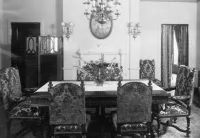
-

- Charmaine Bantugan
National Register of Historic Places - C.E. Toberman Estate
Statement of Significance: This residence was the home of one of Hollywood's leading developers. Built in a style which Mr. Toberman believed synonymous with wealth and glamour, the estate was a principal gathering place and social center during the peak of the community's development. Business, civic, and entertainment leaders were frequent guests. Its association with G.E. Toberman as a visible symbol of his success makes the estate a valuable community landmark. Charles Edward Toberman came to Hollywood in 1907 from Texas. As a real estate developer, he helped to shape the tiny rural community into the home of the motion picture industry. Although not wealthy when he arrived, he worked hard and still found time to participate in civic activities. He was an official of Hollywood when it incorporated as an independent city before its annexation to Los Angeles. Active in many civic and fraternal organizations, he was instrumental in the founding of the Hollywood Bowl and other cultural institutions. He is also credited with forming an alliance between the community and motion picture people and with easing the animosity toward actors which characterized the early years of film development in Hollywood. Toberman was active in both residential and commercial real estate, and many of his ventures have become Hollywood landmarks. Among his most important commercial ventures were Grauman's Egyptian Theatre, Grauman's Chinese Theatre, the El Capitan Theater, Hollywood Roosevelt Hotel, the Montmartre Cafe, and Hollywood Masonic Temple. Residential developments included Outpost Estates; a hillside subdivision popular with the film industry. Toberman was known for his attention to detail; he worked with the finest architects and designers to create a "glamourous" image for Hollywood. As he became a successful entrepreneur, he decided to design a residence in keeping with his status as a civic leader. The Camino Palmero residence was commissioned in 1922 and architects Russell and Alpaugh designed an ornate structure with many' amenities. The hillside setting was uniquely landscaped, providing formal gardens, a tennis court, and riding trails in addition to the luxurious swimming facility. Events at the residence ranged from the formal reception for four hundred for daughter Jeannette's wedding to picnics held by various civic groups such as the Hollywood Round Table. In addition to swimming and tennis, there was a pitch and putt golf course, indoor and outdoor barbecues and a horseshoe pitching range. As well as his real estate company, Mr. Toberman became director of Hollywood's Citizen's Trust and Savings, president of Hollywood Studios president of Federal Trust and Savings Bank and of First Federal Savings and Loan Association of Hollywood (now Pacific Federal Savings) He was active in the Hollywood Chamber of Commerce, the Hollywood Bowl Association Rotary Club of Hollywood, the Hollywood Athletic Club, and Al Mallikah
National Register of Historic Places - C.E. Toberman Estate
Statement of Significance: This residence was the home of one of Hollywood's leading developers. Built in a style which Mr. Toberman believed synonymous with wealth and glamour, the estate was a principal gathering place and social center during the peak of the community's development. Business, civic, and entertainment leaders were frequent guests. Its association with G.E. Toberman as a visible symbol of his success makes the estate a valuable community landmark. Charles Edward Toberman came to Hollywood in 1907 from Texas. As a real estate developer, he helped to shape the tiny rural community into the home of the motion picture industry. Although not wealthy when he arrived, he worked hard and still found time to participate in civic activities. He was an official of Hollywood when it incorporated as an independent city before its annexation to Los Angeles. Active in many civic and fraternal organizations, he was instrumental in the founding of the Hollywood Bowl and other cultural institutions. He is also credited with forming an alliance between the community and motion picture people and with easing the animosity toward actors which characterized the early years of film development in Hollywood. Toberman was active in both residential and commercial real estate, and many of his ventures have become Hollywood landmarks. Among his most important commercial ventures were Grauman's Egyptian Theatre, Grauman's Chinese Theatre, the El Capitan Theater, Hollywood Roosevelt Hotel, the Montmartre Cafe, and Hollywood Masonic Temple. Residential developments included Outpost Estates; a hillside subdivision popular with the film industry. Toberman was known for his attention to detail; he worked with the finest architects and designers to create a "glamourous" image for Hollywood. As he became a successful entrepreneur, he decided to design a residence in keeping with his status as a civic leader. The Camino Palmero residence was commissioned in 1922 and architects Russell and Alpaugh designed an ornate structure with many' amenities. The hillside setting was uniquely landscaped, providing formal gardens, a tennis court, and riding trails in addition to the luxurious swimming facility. Events at the residence ranged from the formal reception for four hundred for daughter Jeannette's wedding to picnics held by various civic groups such as the Hollywood Round Table. In addition to swimming and tennis, there was a pitch and putt golf course, indoor and outdoor barbecues and a horseshoe pitching range. As well as his real estate company, Mr. Toberman became director of Hollywood's Citizen's Trust and Savings, president of Hollywood Studios president of Federal Trust and Savings Bank and of First Federal Savings and Loan Association of Hollywood (now Pacific Federal Savings) He was active in the Hollywood Chamber of Commerce, the Hollywood Bowl Association Rotary Club of Hollywood, the Hollywood Athletic Club, and Al Mallikah
National Register of Historic Places - C.E. Toberman Estate
Statement of Significance:This residence was the home of one of Hollywood's leading developers. Built in a style which Mr. Toberman believed synonymous with wealth and glamour, the estate was a principal gathering place and social center during the peak of the community's development. Business, civic, and entertainment leaders were frequent guests. Its association with G.E. Toberman as a visible symbol of his success makes the estate a valuable community landmark.
Charles Edward Toberman came to Hollywood in 1907 from Texas. As a real estate developer, he helped to shape the tiny rural community into the home of the motion picture industry. Although not wealthy when he arrived, he worked hard and still found time to participate in civic activities. He was an official of Hollywood when it incorporated as an independent city before its annexation to Los Angeles. Active in many civic and fraternal organizations, he was instrumental in the founding of the Hollywood Bowl and other cultural institutions. He is also credited with forming an alliance between the community and motion picture people and with easing the animosity toward actors which characterized the early years of film development in Hollywood. Toberman was active in both residential and commercial real estate, and many of his ventures have become Hollywood landmarks. Among his most important commercial ventures were Grauman's Egyptian Theatre, Grauman's Chinese Theatre, the El Capitan Theater, Hollywood Roosevelt Hotel, the Montmartre Cafe, and Hollywood Masonic Temple. Residential developments included Outpost Estates; a hillside subdivision popular with the film industry. Toberman was known for his attention to detail; he worked with the finest architects and designers to create a "glamourous" image for Hollywood. As he became a successful entrepreneur, he decided to design a residence in keeping with his status as a civic leader. The Camino Palmero residence was commissioned in 1922 and architects Russell and Alpaugh designed an ornate structure with many' amenities. The hillside setting was uniquely landscaped, providing formal gardens, a tennis court, and riding trails in addition to the luxurious swimming facility.
Events at the residence ranged from the formal reception for four hundred for daughter Jeannette's wedding to picnics held by various civic groups such as the Hollywood Round Table. In addition to swimming and tennis, there was a pitch and putt golf course, indoor and outdoor barbecues and a horseshoe pitching range.
As well as his real estate company, Mr. Toberman became director of Hollywood's Citizen's Trust and Savings, president of Hollywood Studios president of Federal Trust and Savings Bank and of First Federal Savings and Loan Association of Hollywood (now Pacific Federal Savings) He was active in the Hollywood Chamber of Commerce, the Hollywood Bowl Association Rotary Club of Hollywood, the Hollywood Athletic Club, and Al Mallikah
Posted Date
Sep 19, 2022
Historical Record Date
Sep 15, 1983
Source Name
National Register of Historic Places
Source Website
Delete Story
Are you sure you want to delete this story?


